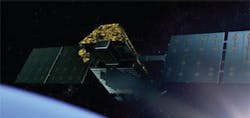AT THE ROOT of Earth's climate change is the amount of radiant energy both entering and leaving the planet. With so little known about the changing climate, a new space-based monitoring system promises to provide much more detail about the differences in that radiant energy. This system, which is being proposed by researchers at The Johns Hopkins University Applied Physics Laboratory (APL), is dubbed Earth's Radiation Imbalance System (ERIS). It would comprise small radiometers each roughly the size of a red clay brickintegrated into each of the 66 satellites within Iridium's next-generation NEXT constellation (scheduled for deployment in 2015).
For decades, climate-change studies have relied on incomplete and sporadic data to create climate models. In contrast, ERIS would provide detailed, nearly constant global data about energy changes on Earth. The system also will let researchers analyze in near-real time how clouds, hurricanes, and volcanoes affect outgoing radiant energy.
Developed as a NASA Earth Venture-2 mission proposal, ERIS would operate as a hosted payload aboard the Iridium NEXT satellites. ERIS would utilize the Iridium NEXT satellites as the largest single satellite constellation that has yet been available for a NASA science missionand at a fraction of traditional mission costs associated with a single satellite. Inspiration for ERIS came in part from the success of AMPERE, a 2010 research project involving APL and Iridium's current 66-satellite network. Using existing devices on the satellites, AMPERE generates real-time magnetic-field measurements as part of a new observation network to forecast weather in space.
The ERIS proposal boasts an experienced team: APL's Cindy K. Kim serves as Project Manager while Iridium is represented by Om Gupta, Director of Business Development for Iridium NEXT. The Science Lead and Deputy Principal Investigator (PI) is Warren J. Wiscombe, Senior Scientist, NASA Goddard Space Flight Center, and former Chief Scientist of the Department of Energy's Atmospheric Radiation Measurement (ARM) program. Steven R. Lorentz of L-1 Standards and Technology serves as Deputy PI. The Charles Stark Draper Laboratory would build the ERIS instruments. A core team has been assembled with researchers representing NASA, the National Center for Atmospheric Research (NCAR), Brookhaven National Laboratory, and universities across the US and Canada.
As the industry waits to see what happens with the AMPERE proposal, NASA is moving forward on its own climate-change research. On October 27, the agency launched the first Earthobserving satellite to measure both global climate changes and key weather variables. The National Polar-orbiting Operational Environmental Satellite System Preparatory Project (NPP) will collect critical data to improve weather forecasts in the short-term and increase the understanding of long-term climate change. NPP's five science instrumentsincluding four state-of-the-art sensorswill provide scientists with data to extend more than 30 key, long-term datasets. These records, which range from the ozone layer and land cover to atmospheric temperatures and ice cover, are critical for global change science. NPP serves as a bridge between NASA's Earth Observing System of satellites and the planned Joint Polar Satellite System (JPSS), which will collect climate and weather data. JPSS will be developed by NASA for the National Oceanic and Atmospheric Administration (NOAA).
